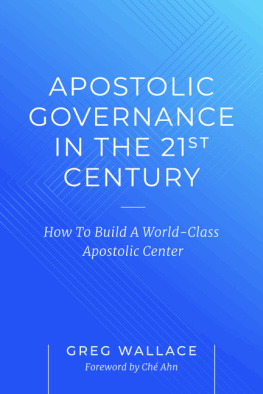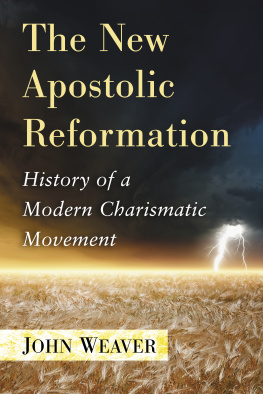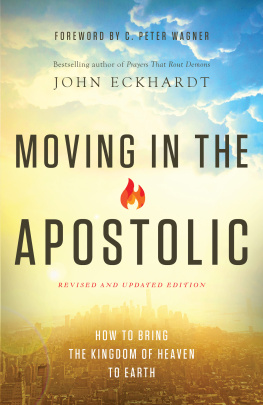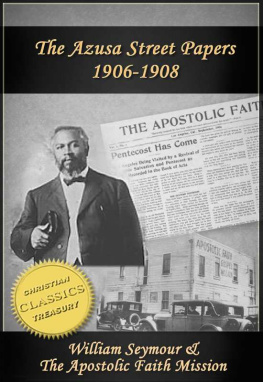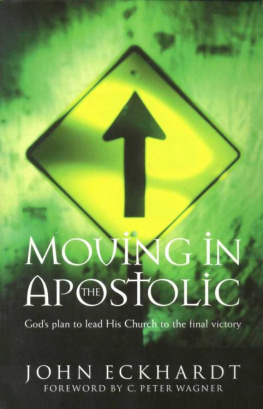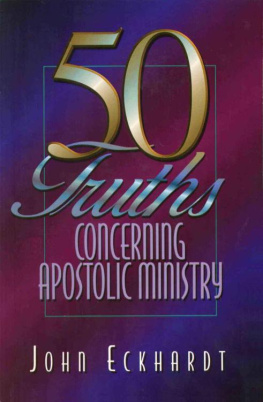PART ONE
Setting The Proper Foundation
When we think of something as world-class, we think of it as ranked by experts to be among the best of the best. But that is not how the term is used here.
When I say world-class apostolic centers, I am not talking about world-class in comparative terms, as in world-class is better than other classes. It is certainly not my intent to rank apostolic centers, even in the broadest of terms.
My definition of a world-class apostolic center flows out of Pastor Ch Ahn s definition of an apostle, and it is based on spiritual rather than organizational concepts. A world-class apostolic center has a specific call from the Lord to exercise a regional, national, or international sphere of influence; furthermore, it has a specific assignment to align the Church to bring Heaven s culture to earth and thus fulfill the Great Commission mandate of discipling nations.
An apostolic center is not world-class because of the size of its ministry. It is world-class because of its sphere of influence on the Earth. It is a change agent that transforms society in its region, nation, or internationally. It exercises influence in all seven spheres of culture by identifying, empowering, equipping, and releasing people in each sphere to bring revival and reformation in their sphere of influence.
Chapter One:
The New Wineskin
Any discussion of the rise of apostolic centers must begin with the recognition that the office of the apostle and the office of the prophet have been restored. (For a great discussion of the restoration of these offices, read the introduction in Pastor Ch s book Modern-Day Apostles: Operating In Your Apostolic Office and Anointing . )
As the office of apostle began to be recognized, God, of course, made room for the gift of the apostle. As with many shifts in the new apostolic age, Dr. Peter Wagner was at the forefront of identifying the paradigm shifts that accompanied the modern emergence of apostles.
In Changing Church: How God Is Leading His Church Into The Future , published in 2004, he discussed some of the impacts of this emergence on the Body of Christ. He identified the differences between a local church and an apostolic church, the differences between a pastoral mindset and an apostolic mindset, and the differences between a church vision and a kingdom vision.
By 2012, apostolic churches had become known as apostolic centers. In June of that year, Glory of Zion published Dr. Wagner s PowerPoint on apostolic centers. In the presentation, he described apostolic centers within the context of their differences with local churches. In doing so, he not only provided a clear definition of apostolic centers; he crystallized the difference between a Church Mindset and an Apostolic Mindset. Dr. Wagner's teaching may not have launched apostolic centers, but it certainly accelerated their growth.
As a horizontal apostle, one who is gifted in gathering other apostles, Dr. Wagner was able to convene the first national conference devoted entirely to apostolic centers. The Apostolic Centers Arising Conference was called by Dr. Wagner and hosted by Chuck Pierce at Global Spheres Center in Corinth, Texas, USA in June of 2014. Pastor Ch was one of the keynote speakers, as were several apostles from his apostolic network, Harvest International Ministry.
The conference was well received, to say the least. As one observer wrote:
This Consultation on Apostolic Centers was off the charts. Today our Kingdom Watchmen weekly prayer group watched a couple of the sessions. They were stunned with what they heard the new understanding of the new we have all been hearing about the apostolic anointing of power and authority that came forth from every speaker. The speakers were all apostles who told their story whether they had up and running apostolic centers or were in the process of establishing one. There is so much more that has, is and will happen, than you can even imagine. That is how good it is and how faithful, powerful and sovereign our Lord is.
As of this writing, the date of the conference was just four years ago. So, you can see, apostolic centers are a relatively new dimension in the Body of Christ.
Nevertheless, their impact is already being felt. The emergence of apostolic centers is the most radical shift coming to shake the global Christian world today. T hey are already playing a central role in the government of the kingdom of God.
The establishment of apostolic centers is turning into a tidal wave. Like waves, apostolic centers are coming one after the other as apostolic centers help launch other apostolic centers.
This growth of apostolic centers represents an even more important growth: the growth of the influence of apostles and prophets. A fully functioning five-fold ministry is critical if we are to see the advancement of the Kingdom of God and the discipling of nations.
Thus, it is even more important that new-wineskin apostolic centers be whole and complete.
Chapter Two:
The New Wineskin Has A Patch
While the emergence of modern-day apostles and apostolic centers is important, neither replaces pastors and local churches. Both are necessary! One does not displace the other. They are complementary.
However, they are different.
The difference between apostolic leadership and pastoral leadership has been well chronicled: The Senior Pastor in a traditional church reports to a board of elders or a board of deacons. He is, for all intents and purposes, an employee. The Lead Apostle in an apostolic center is not an employee but the equivalent of a CEO.
The difference between how an apostle is wired and how a pastor is wired has been well chronicled: The pastors desire is to get all the sheep in the sheepfold so that she can heal them up. The apostles desire is to equip them and send them to the ends of the earth to impact all spheres of society!
The difference between how an apostolic center ministers and how a local church ministers has also been well chronicled: While Church Thinking is focused on ministering to the saints, an apostolic center is focused on equipping the saints.

The difference between how an apostolic center is managed and how a local church is managed has not been chronicled: As I mentioned earlier, there are relatively few books that discuss church governance, and if there are any books to date that discuss governance in apostolic centers, I am not aware of them. This is no small oversight. Let s begin to examine why the lack of governance that is specific to apostolic centers is so significant.
Most of us are familiar with Jesus comparison of wineskins: And no one puts new wine into old wineskins; or else the new wine will burst the wineskins and be spilled, and the wineskins will be ruined. But new wine must be put into new wineskins, and both are preserved (Luke 5:37-38). We understand the danger of using an old wineskin instead of a new one for new wine.
Apostolic centers are being described as a new wineskin. Local churches are being described as the old wineskin. Asking apostles and prophets, i.e., the fully restored five-fold ministry, to operate in a local church setting would be like pouring new wine into old wineskins.
But is this the most accurate analogy?
When a local church becomes an apostolic center, its leadership shifts from a Senior Pastor to a Lead Apostle, but an administrative pastor still manages it. In other words, the new wineskin is not completely new. Thus, Jesus comparison of old and new garments may be the more appropriate analogy. No one puts a piece from a new garment on an old one; otherwise the new makes a tear, and also the piece that was taken out of the new does not match the old (Luke 5:36).

